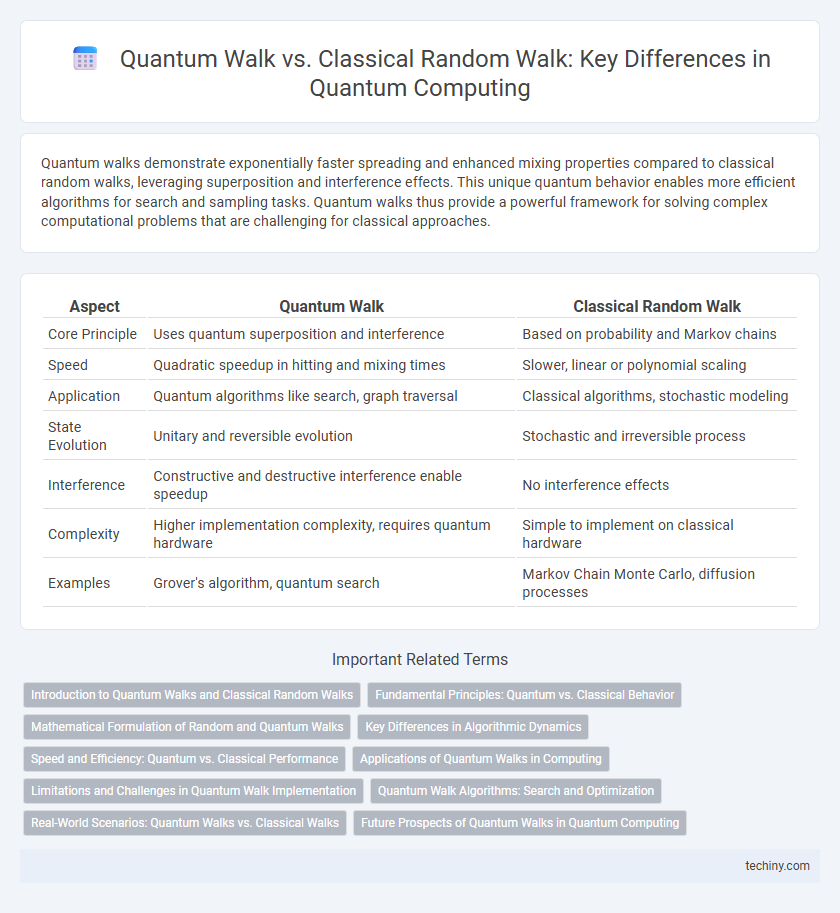Quantum walks demonstrate exponentially faster spreading and enhanced mixing properties compared to classical random walks, leveraging superposition and interference effects. This unique quantum behavior enables more efficient algorithms for search and sampling tasks. Quantum walks thus provide a powerful framework for solving complex computational problems that are challenging for classical approaches.
Table of Comparison
| Aspect | Quantum Walk | Classical Random Walk |
|---|---|---|
| Core Principle | Uses quantum superposition and interference | Based on probability and Markov chains |
| Speed | Quadratic speedup in hitting and mixing times | Slower, linear or polynomial scaling |
| Application | Quantum algorithms like search, graph traversal | Classical algorithms, stochastic modeling |
| State Evolution | Unitary and reversible evolution | Stochastic and irreversible process |
| Interference | Constructive and destructive interference enable speedup | No interference effects |
| Complexity | Higher implementation complexity, requires quantum hardware | Simple to implement on classical hardware |
| Examples | Grover's algorithm, quantum search | Markov Chain Monte Carlo, diffusion processes |
Introduction to Quantum Walks and Classical Random Walks
Quantum walks leverage the principles of superposition and interference to explore paths simultaneously, offering exponential speedup in certain computational tasks compared to classical random walks, which rely on probabilistic transitions between adjacent states. Classical random walks model stochastic processes and diffusion through memoryless stepwise movements, often used in algorithms and statistical physics. Quantum walks serve as foundational tools in quantum algorithms, enabling enhanced search and sampling capabilities by exploiting quantum coherence and entanglement.
Fundamental Principles: Quantum vs. Classical Behavior
Quantum walks leverage superposition and interference, enabling particles to explore multiple paths simultaneously, unlike classical random walks which follow a probabilistic path defined by fixed transition probabilities. The quantum coherence allows for faster propagation and hitting times, highlighting intrinsic non-classical dynamics absent in classical stochastic processes. These fundamental differences in behavior underpin quantum algorithms that outperform classical counterparts in search and sampling tasks.
Mathematical Formulation of Random and Quantum Walks
Classical random walks are mathematically formulated using Markov chains with transition probability matrices defining the stochastic process on discrete states. Quantum walks employ unitary evolution operators on Hilbert spaces, utilizing superposition and interference through coin and shift operators to govern state transitions. The mathematical distinction centers on probability distributions governed by stochastic matrices in classical walks versus amplitude distributions derived from unitary matrices in quantum walks, leading to fundamentally different spreading behaviors and computational properties.
Key Differences in Algorithmic Dynamics
Quantum walks utilize superposition and interference, enabling faster spreading over a graph compared to the diffusive nature of classical random walks driven by probabilistic transitions. The unitary evolution in quantum walks preserves coherence, allowing for quadratically faster mixing times and hitting times on certain graph structures. Classical random walks rely on Markov chains with stochastic matrices, leading to exponential convergence times in contrast to the linear or polynomial times achievable by quantum walk algorithms.
Speed and Efficiency: Quantum vs. Classical Performance
Quantum walks exhibit significantly faster spreading rates than classical random walks, enabling more efficient exploration of complex computational spaces. Leveraging quantum superposition and interference, quantum walks achieve quadratic speedups in hitting and mixing times compared to classical algorithms. This enhanced efficiency directly translates into improved performance for applications such as graph traversal, search algorithms, and optimization tasks.
Applications of Quantum Walks in Computing
Quantum walks provide exponential speedups in algorithms for database search and graph traversal compared to classical random walks, enabling more efficient solutions for problems like element distinctness and triangle finding. Quantum walk-based algorithms underpin advances in quantum simulation, cryptography, and optimization by exploiting superposition and interference properties inherent to quantum mechanics. These applications demonstrate quantum walks as fundamental tools in developing next-generation quantum computing protocols with superior computational power.
Limitations and Challenges in Quantum Walk Implementation
Quantum walk implementation faces significant challenges including maintaining qubit coherence and managing error rates in quantum systems, which hinder scalability and practical application. Unlike classical random walks, quantum walks require precise control over superposition and entanglement, demanding advanced hardware and error correction techniques that are still under development. These limitations result in restricted algorithmic efficiency and complicate the practical realization of quantum walk-based algorithms in current noisy intermediate-scale quantum (NISQ) devices.
Quantum Walk Algorithms: Search and Optimization
Quantum walk algorithms leverage the principles of superposition and interference to explore search spaces more efficiently than classical random walks, providing polynomial or exponential speedups in specific problems. They underpin advanced optimization techniques by enabling faster mixing times and hitting times, which enhance search algorithms for graph-based structures. Key applications include element distinctness, spatial search, and network optimization, demonstrating significant improvements in computational complexity over traditional methods.
Real-World Scenarios: Quantum Walks vs. Classical Walks
Quantum walks offer exponential speedup in search algorithms and network traversal compared to classical random walks, enhancing efficiency in problem-solving for complex systems like molecular simulations and optimization tasks. In physical implementations, quantum walks enable more precise modeling of quantum transport phenomena seen in photosynthesis and energy transfer within quantum materials. Real-world applications benefit from quantum walks' ability to exploit superposition and interference, providing superior performance in sampling, routing, and cryptographic protocols.
Future Prospects of Quantum Walks in Quantum Computing
Quantum walks exhibit superior algorithmic efficiency compared to classical random walks, enabling faster search algorithms and enhanced problem-solving capabilities in large-scale quantum systems. Their potential in quantum computing lies in optimizing complex computational tasks like graph traversal, machine learning, and optimization problems, which classical methods struggle to efficiently handle. Ongoing research aims to harness quantum walks for developing fault-tolerant quantum algorithms, scalable quantum networks, and robust quantum simulations, signaling transformative advancements in future quantum technologies.
quantum walk vs classical random walk Infographic

 techiny.com
techiny.com